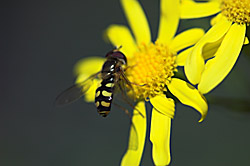Nikon Micro Nikkor 200mm f/4 D (IF) ED
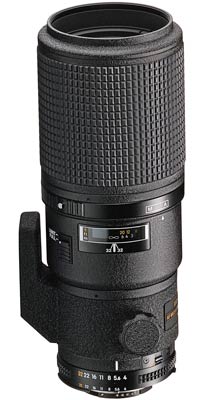 This lens is the longest focal length in Nikon’s line-up of Macro lenses. Nikon call them Micro, but they do the same job as everybody else’s Macro lenses and that is to produce images that are a 1:1 ratio on the film or sensor. Not only is it Nikon’s longest, but the longest prime macro lens available. We take a look at how it performs.
This lens is the longest focal length in Nikon’s line-up of Macro lenses. Nikon call them Micro, but they do the same job as everybody else’s Macro lenses and that is to produce images that are a 1:1 ratio on the film or sensor. Not only is it Nikon’s longest, but the longest prime macro lens available. We take a look at how it performs.
Specification
- Focal Length 200mm
- Aperture f/4
- Angle of view N/Aº
- Filter size 62mm
- Construction 13/8 elements/groups
- Focus type Internal
- Closest focus 500mm (1:1)
- Weight 1190g
- Dimensions 76x193mm
- Mounts available Nikon
- Tripod bush Yes,
- Price (SRP) £1300
Build and Handling
The lens comes supplied in a hard, tubular leatherette case that immediately shouts quality at you. The case is lined with brown velvet that further re-enforces this feel. Withdrawing the lens from the case reveals a solid looking piece of equipment, metal bodied, with a huge focus ring that occupies almost half the barrel.
Immediately in front of the mount is the aperture ring with a lock at f/32 for modern auto cameras. The non-removable tripod mount ring takes up the next 32mm. The fact that the mount could not be removed did not prove a problem for two reasons, firstly, the lens proved virtually impossible to hand hold and secondly the mount itself was fairly low profile and did not protrude.
Forward of this is a distance window which is marked with a depth-of-field scale that is safely in the category of ‘completely useless’! Marked at f/32 only, it looked more like an arrowhead and only served to highlight one of the biggest drawbacks of this type of lens. More later. Alongside is a limit switch for the focus.
Next up is the AF/MF switchover ring, a dated affair with a small press-button lock. The remainder of the lens barrel is taken up with over 75mm of focus ring, which has a very nice feel to it, something that is handy as the full focus travel takes three quarters of a turn.
Autofocusing was painfully slow and quite noisy by modern standards. It was, however, accurate to the selected focus point on the camera. It is not possible to over-ride the autofocus manually without changing the switch to manual.
Optical Quality
This lens is an adequate performer, but again by modern standards, not outstanding. Due to the long focal length (for a macro), focussing is critical as very little depth-of-field is achievable. Distortions and aberrations of all kinds are well controlled, as they should be with the inclusion of ED glass. Sharpness is good within this limited depth-of-field.
|
| 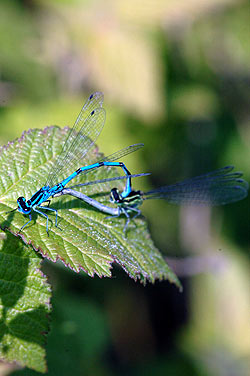 At f/9 it has improved, but not much better |
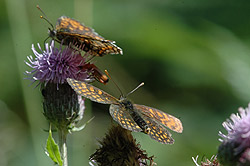 At f/13. Still not great |
 Nikon 200mm set at f/4 | Nikon 200mm set at f/8
Click on each of these two comparison photos to view full size versions |
Below is our lens test data. To find out how to use this graph look at this article: How we test lenses
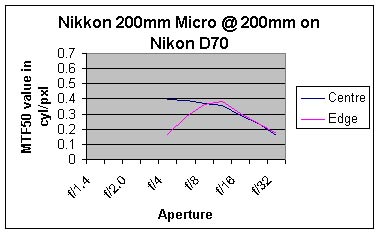
Verdict
Despite its obvious quality, this lens does seem to be a little long in the tooth. More suited to specialised macro duties on a tripod than as a general purpose macro lens, it prove extremely hard to hand hold and get decent results. If you are thinking that the long focal length will be ideal for chasing bugs and butterflies, you will need to go crashing through the undergrowth with a tripod in tow! Consider a 70-200mm VR and extension ring instead. A lens in need of an update.
In summary the main positive points of the Micro Nikkor 200mm f/4 D (IF) ED are:
![]() Exceptional build quality
Exceptional build quality
![]() Good tripod collar (needed)
Good tripod collar (needed)
![]() Good CA/distortion control
Good CA/distortion control
Negative points are:
![]() Geriatric autofocus
Geriatric autofocus
![]() Dated switching
Dated switching
![]() Narrow depth-of-field
Narrow depth-of-field
Check the latest price of the Micro Nikkor 200mm f/4 D (IF) ED here and help support the site.
Test by Ian Andrews www.wildaboutkent.co.uk
http://www.naturfotograf.com/index2.html
The review is to let people know what to expect from the lens and, IF YOU READ IT, that is what it does. Not everyone knows what to expect and those people will more likely be using a D70 than a D2X.
Ian
This Micro Nikkor is not the longest macro, there is also the Minolta 200mm Apo Macro. They share the same specifications (so are they actually optically the same...). Both have internal focusing and the closest focusing distance of 50 cm meaning that their actual focal lenght is 125 mm at 1:1.
However, the Minolta lens is not made by Nikon, therefore:
"This lens is the longest focal length in Nikon’s line-up of Macro lenses" is correct!
I also use the 70-200VR and yes I have already used it with extension rings (PN-11,PK-13) and also with the Nikon 6T dioper and it is absolutely no match for the 200/4.
And of course you use the 200/4 on a tripod.All serious macro photography is still done on a tripod.VR is nice and helps till a certain degree but is certainly not a substitute for a tripod.I advise you to get out in the field and try the real thing....which you obviously haven't done till now.Sorry!
"This lens is the longest focal length in Nikon’s line-up of Macro lenses" is correct!
Yes you are right concerning the Nikon label, but you did not comment my claim that they would be optically the same. Actually I once found a Japanese web page showing their internal optical construction side by side and they were identical - unfortunately my Japanese is not perfect so I did not get the message :-).
So perhaps some guy designed a nice 200 mm macro and sold the specs to both Nikon and Minolta or Nikon sold the specs to Minolta, because the original Micro Nikkor 200mm dates back to 1979 and Minolta 200mm APO Macro was released in 1999 (and is now discontinued). The current Micro Nikkor looks different, but if you compare the original Micro Nikkor to Minolta, they look quite similar.
But something is correct here, and that is the need for a facelift. When it comes to speed and ease of use the 200/4 feels dated compared to a flashy new 105 VR. Yes, macro is 90% manual focus and the control of this lens' focus ring is second to none, but AF-S and VR are natural additions and no doubt they will come one day, along with a convenient, not to mention included, bayonet hood perhaps?
Rest assured, however, that the 200/4's shots are sharp and its bokeh handsome. The 0.5m working distance is invaluable. This lens is also a fine 200mm in good light, although I must stress that the AF is the slowest I've ever seen and if you need AF to perform you must look elsewhere.
Otherwise, top quality lens with very few flaws.
(btw, I would not recommend this lens to someone who wants to chase bugs, instead I would recommend to lure the bugs to a nice pre-defined spot with proper light and background and then Micro200wave them! :-)
"This lens is an adequate performer, but again by modern standards, not outstanding."
"Due to the long focal length (for a macro), focussing is critical as very little depth-of-field is achievable."
Ahahahaaa... mercy me.
the following link shows a non-macro shot..
http://www.pbase.com/dreams202/image/65698370
which is sharper than my nikkor 70-200 f/2.8 VR
The reviewer said: "More suited to specialised macro duties on a tripod than as a general purpose macro lens, it prove extremely hard to hand hold and get decent results."
While true, I find it amusing that he tried to use a 200mm macro lens to take macro shots handheld. Really, the only way to get accurate framing and focussing with such a lens due to the shallow DOF is to use a tripod. In fact I would not really use any macro lens handheld, though some people do get good results when using flash.
The reviewer also comments on the "Geriatric autofocus". Whilst a true statement, it is irrelevant for macro photography, where critical focussing is done manually.
Looking at the example image of a harbour I am struck by the poor image quality. It really is unacceptable for such an expensive lens. Now it could be a duff sample of the lens, but given that the lens is already stopped down to F8, my guess is that the softness is due to vibration. From personal experience I know that Nikon 200mm micro lenses (both AF and MF) are prone to vibration, caused largely by mirror slap, and that mirror lock up is essential. I note that the reviewer used a D70, which lacks MLU, so I am not too surprised the image quality is low. I wonder how he created the MTF chart? I did tests with a Nikon 200mm F4 MF lens, and I could not get sharp results without MLU unless the shutter speed exceeded 1/400", or a bean bag was placed on top of the camera (not the lens). I also got good results when I placed the lens on a bean bag resting directly on the ground. I have no idea if similar lenses from other manufacturers are also prone to vibration, but I would guess they are.
My copy of this lens is incredibly sharp at almost all apertures, including wide open. But first rate technique is essential including MLU, and a high quality tripod and head as the lens is unforgiving.
And as the reviewer rightly indicates, no-one should buy a 200m macro lens as a general purpose macro lens.
It's quite true that some of us have been a bit harsh in our rebuffs, but I believe that if you ever decide to set up website and write reviews about lenses (or anything) you have to do so fairly, accurately and you must take into account what need a particular lens fulfills and what sort of photographer would like it. You must also know what you're talking about. Suggesting that the shallow depth of field exhibited by the 200/4 is somehow a fault shows a lack of basic understanding by photodo.com, what when any other 1:1 macro lens on earth will suffer the same perceived problem.
It's no good saying either; 'Can you write a better review?' because if we all thought like that no one would dare criticize anything. I can't play football, but I can criticize a professional player's performance. I may not be the best photographer, but I can like or dislike a photo or fellow photographer's tastes/opinions. Same deal with reviews and those whom write them.
A review that wrongly discredits anything should itself be discredited so it does not mislead others, and that's what has happened here to a comprehensive degree.
I would just note that the 50cm (or 26cm from the end of lens) working distance is the whole point of buying the 200/4. Optically it's as good as any macro is.
The comments about handling without a tripod are generally true as this bulky and slow lens can be quite awkward to use hand-held. The tripod collar is easily rotated out of the way and poses no real obstacle to hand-holding the lens. However, if the user is skilled at using the AF system and also uses flash (or is fortunate to have a great deal of ambient light), this lens is an adequate tool for some classes of chasing flitty bugs and other critters. The skilled use of the AF is mandatory here, because an AF hunt on this lens is the rough equivalent of a two-week paid vacation for the shutter. It is also long enough that the photographer's brain can get distracted - a hunt is really long time! Fortunately as others have noted, this lens is really much better in more deliberate shooting environments, where manual focus is the order of the day. Focus and DOF considerations are extreme, so a magnifying eyepiece is highly recommended.
A note on the harbor images above: the door of the museum looks notably soft, but inspecting the full image reveals that the focus point is some meters closer than the door, and the black capstan is much sharper. I cannot explain the overall softness of the view of the harbor unless the problem is atmospheric - which is entirely possible.
Brian Wong
Gordonsville, VA
Several months ago I decided to buy a long, high-end macro for my Nikon D200. I already have a Nikon 105/2.8, which produces very sharp pictures, and my new one should not be worse than the 105mm. However, I am not able to choose between Sigma 150/2.8 and Nikon 200/4, mainly because most of the readers comments above. Consequently , I digested several test results involving the two lenses, but the tests all seem nearly useless, mainly because I work macro 1:1. The above test gives Nikon 200/4 a max resolution (sharpness) of just below 0.4, while the Sigma 150/2.8 ends up more or less equally sharp (these results are re-produced in www.ephotozine.com).
Another site, with different analyzes of the two lenses, is www.photozone.de, which lists resolution as MTF. In their analyzes Nikon 200/4 receives a center resolution of 1928 (F11) to 2055.5 (F5.6), while the Sigma 150/2.8 receives a resolution of between 1836.5 (F16) and 2251 (F5.6) [F11 excluded from the analyzes of Sigma], i.e. better than the Nikon lens. Even with a 1.4x tele-converter mounted on the Sigma lens, it produces better results than the Nikon without tele-converter [values 1929 (F11) – 1990.5 (F8)]. This, despite the extra glass added. I think this illustrates that the Sigma alternative might be better when considering sharpness alone.
A third test was published in the Swedish magazine “Foto”, issue 7-8 (2007). The magazine tested 19 macro lenses, among them the Nikon 200/4 and Sigma 150/2.8. A nice detail in the tests was that they included tests at 1:2 (half natural size). In the tests MTF sharpness was given between 0.0 and 1.0. The two lenses were very similar at 1:2, except at F8, where Nikon received 0.75 and Sigma slightly above 0.8.
Add your message
Please login here or if you've not registered, you can register here. Registering is safe, quick and free.
photodo Stats
428 MTF tests
74 in-depth photodo reviews
100+ users join each day
Help the lens community by reviewing or rating a lens today via our lens search
Latest Lens Reviews
- Chinon 28mm f/2.8 Vintage Lens Review
- Canon EF 70-200mm f/4L IS II USM Lens Review
- Samyang AF 85mm f/1.4 EF Review
- Sigma 70mm f/2.8 DG Macro Art Review
- Samyang AF 24mm f/2.8 FE Review
- Meike 50mm f/1.7 Review
- Tamron 70-210mm f/4 Di VC USD Review
- Lensbaby Burnside 35mm f/2.8 Review
- Asahi Super Takumar 50mm f/1.4 Review
- Asahi Super-Multi-Coated Takumar 135mm f/3.5 Review
